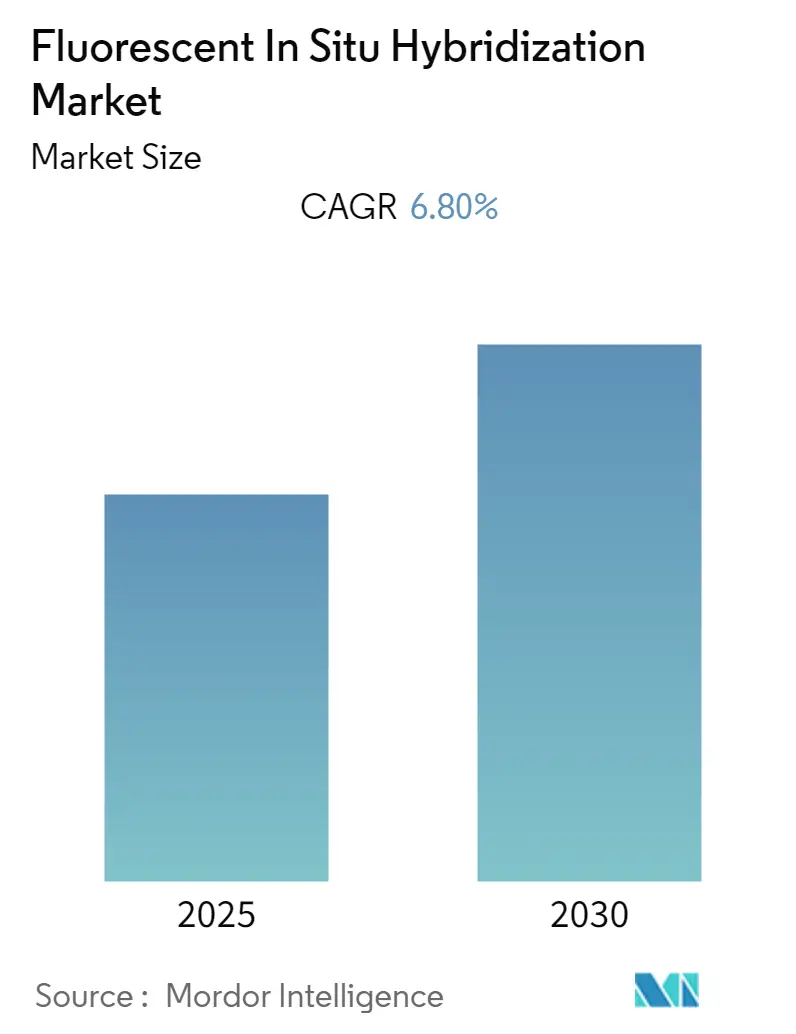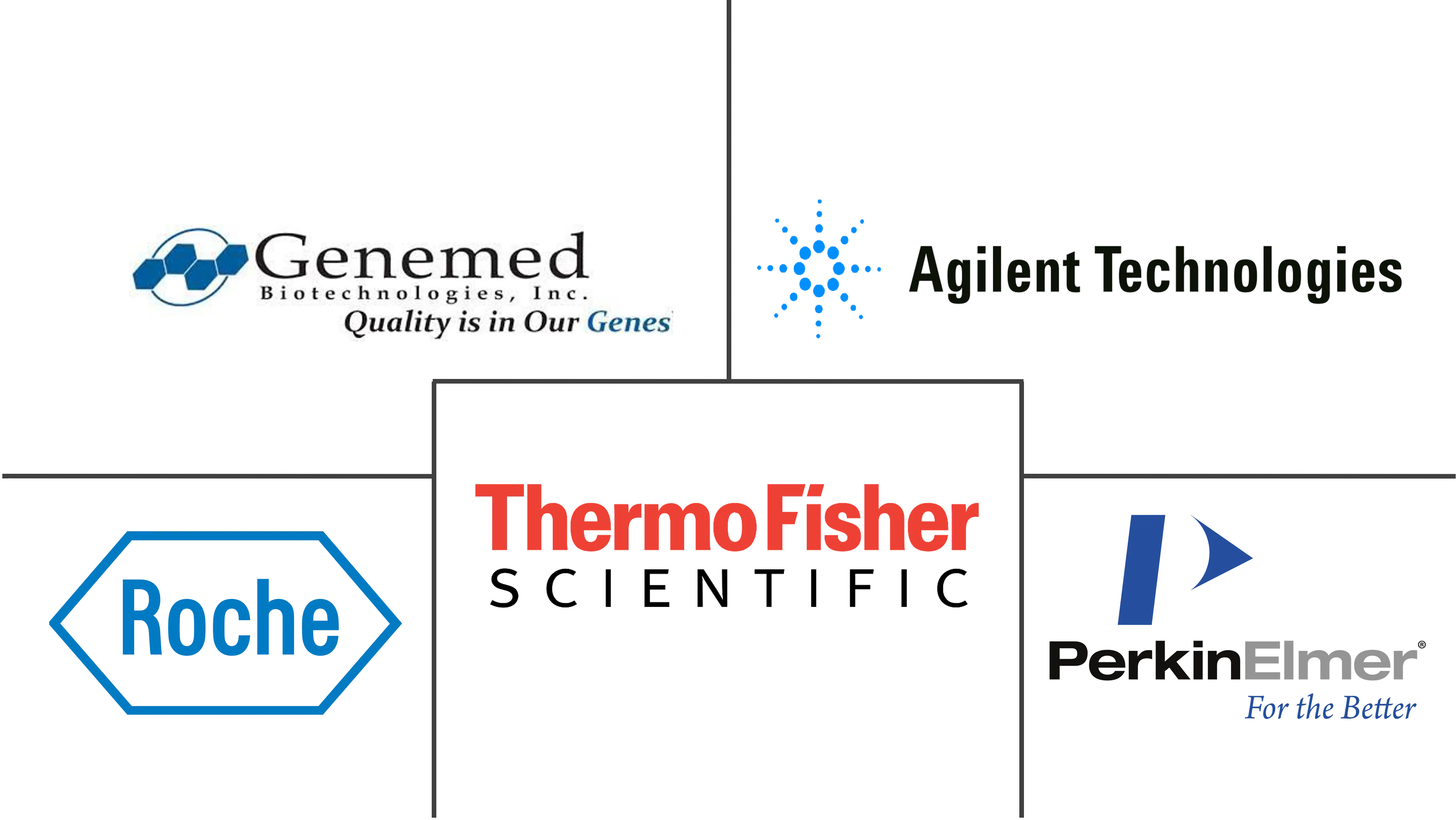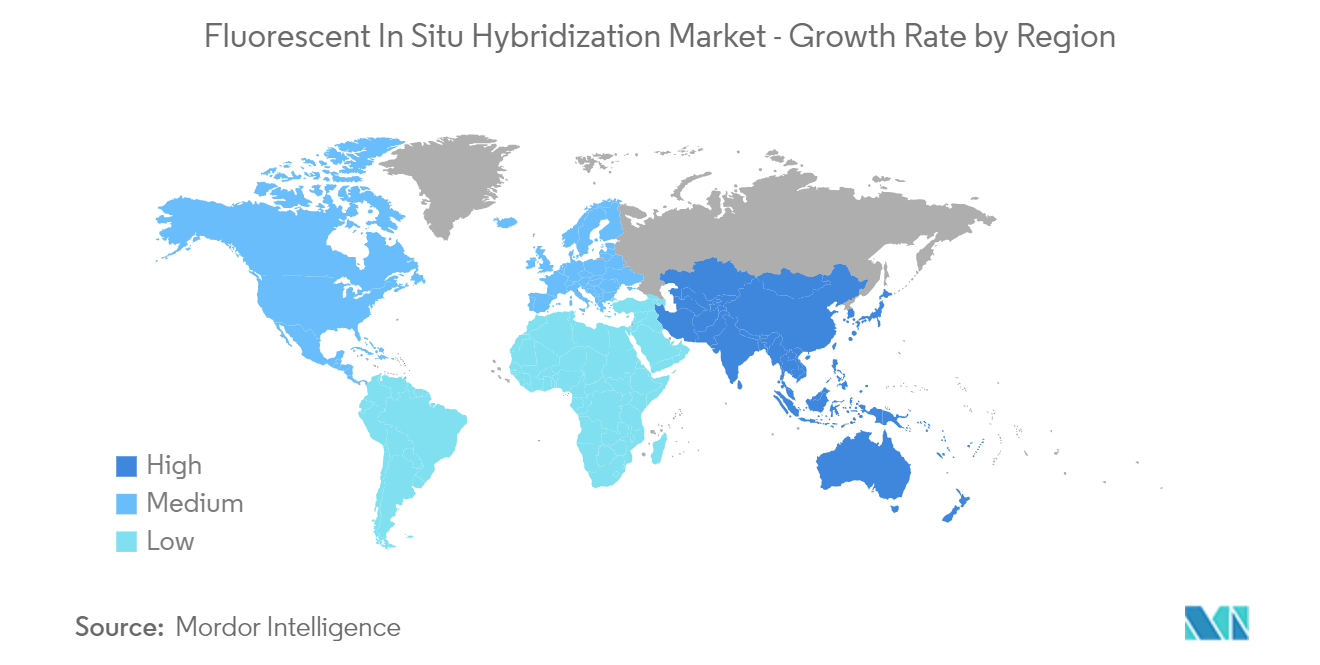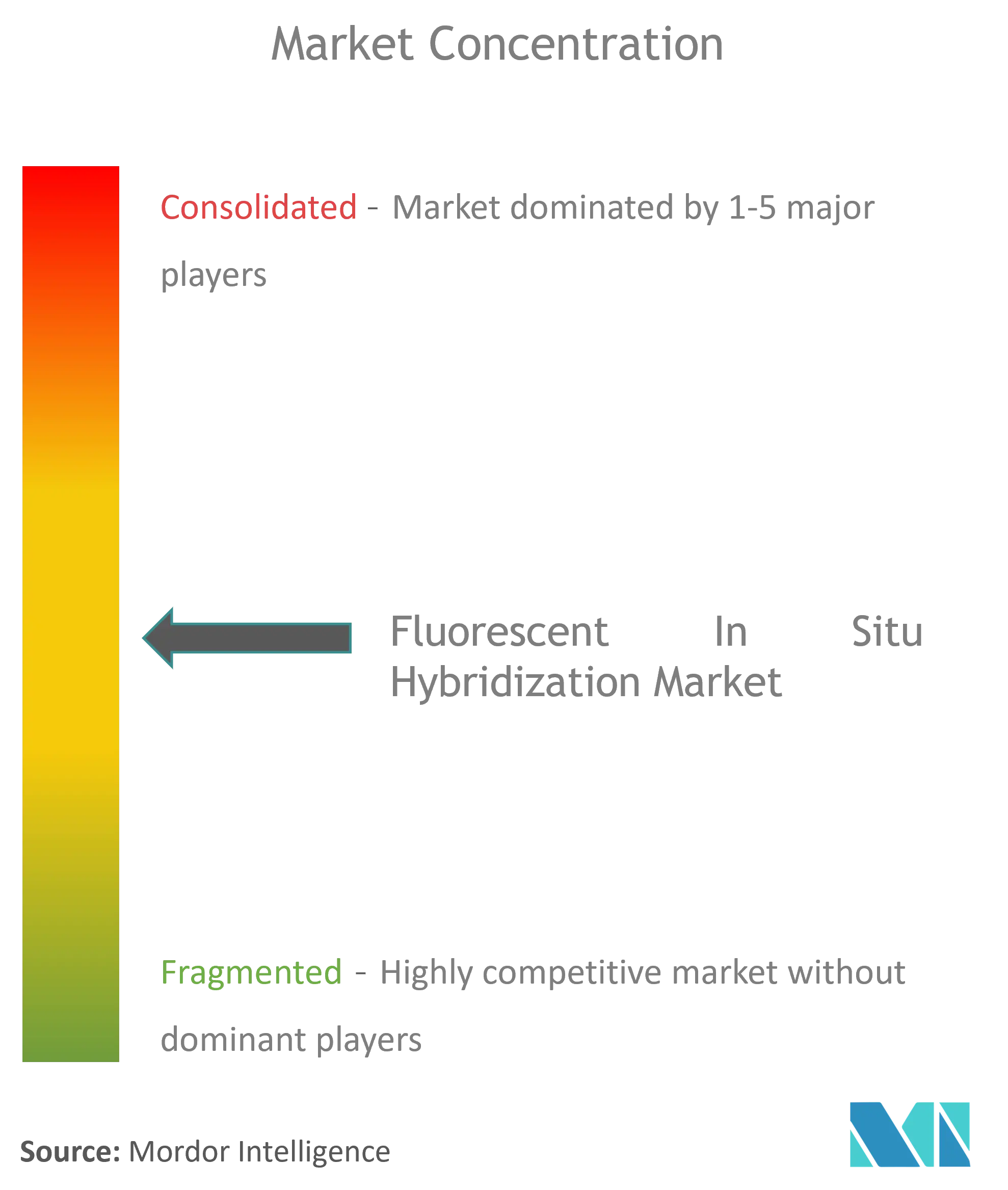
| Study Period | 2019 - 2030 |
| Base Year For Estimation | 2024 |
| Forecast Data Period | 2025 - 2030 |
| Historical Data Period | 2019 - 2023 |
| CAGR | 6.80 % |
| Fastest Growing Market | Asia Pacific |
| Largest Market | North America |
Major Players
*Disclaimer: Major Players sorted in no particular order |
Fluorescent in Situ Hybridization Market Analysis
The Fluorescent In Situ Hybridization Market is expected to register a CAGR of 6.8% during the forecast period.
COVID-19 profoundly impacted the studied market owing to the rising research studies deploying fluorescence in situ hybridization. For instance, in an article published in the PLOS One Journal in November 2022, fluorescence in situ hybridization (FISH)-based evaluation method was used for the detection of SARS-CoV-2 in saliva. All saliva samples were FISHed with a Cy3-labeled SARS-CoV-2-specific DNA probe and were analyzed manually by fluorescence microscopy (proof-of-concept). However, the market is expected to show a stable growth rate during the forecast period owing to the rising prevalence of cancer and genetic diseases globally.
In addition, the growing burden of cancer and genetic diseases and innovation in FISH products are actively affecting the growth of the studied market.
According to the Canadian Cancer Society May 2022 update, it was estimated that 30 thousand Canadians would be diagnosed with lung and bronchus cancer, representing 13% of all new cancer cases in 2022. As fluorescent in situ hybridization is used to diagnose various types of cancer to find chromosomal abnormalities, there is an increasing demand for FISH, thereby driving the market.
Furthermore, fluorescence in situ hybridization (FISH) is used to detect and locate a specific DNA sequence on a chromosome. It is also used as a molecular cytogenetic technique to diagnose genetic diseases. For instance, according to the World Alzheimer Report published in September 2021, over 55 million people live with dementia worldwide. This is forecasted to reach 78 million by 2030. Also, as per the Alzheimer's Association 2021 report, an estimated 6.2 million Americans aged 65 and older were living with Alzheimer's dementia in 2021 in the United States. By 2050, the number of people aged 65 and older with Alzheimer's dementia is projected to increase to 12.7 million. The increasing burden of Alzheimer's disease globally surges the demand for FISH used in the genetic testing of the disease condition, thereby leading to the growth of the studied segment market.
FISH is mainly used for locating specific DNA sequences, diagnosis of genetic diseases, and gene mapping; its use in genomics is vital. The increasing funding and investment by biotechnology and pharmaceutical companies and government organizations for research and innovation in the field of genomics is estimated to propel market growth. For instance, according to the NIH National Human Genome Research Institute (NHGRI) 2022 report, the FY 2022 United States President's Budget request for human genomics research is USD 633.0 million, an increase of USD 17.0 million compared with the previous year. In order to improve human health, NHGRI interacts with a variety of groups, performs and funds genomics research, and educates the next generation of genomics specialists. The huge investment by the NHGRI in the genomics study is expected to utilize a large amount of FISH during the research, which is expected to propel the market growth during the forecast period.
Therefore, owing to the aforementioned factors, such as the high prevalence of cancer and genetic diseases and rising funding leading to the high utility of FISH, the studied market is anticipated to witness growth over the analysis period. However, a lack of awareness about emerging diagnostic technologies in cytogenetics is likely to impede market growth.
Fluorescent in Situ Hybridization Market Trends
Cancer Segment is Expected to Show a Significant Growth in the Fluorescent In Situ Hybridization Market
The cancer segment is anticipated to hold a significant market share over the forecast period owing to the factors such as the growing presence of in vitro diagnostics, the high burden of cancer globally, and rising technological advancements in fluorescent in situ hybridization used for cancer diagnosis.
Cytogenetic technique plays a crucial role in the detection of cancer chromosomal abnormalities. According to the American Cancer Society Cancer Statistics 2023, 1.9 million new cancer cases are predicted to be diagnosed in the United States in 2023. Also, as per the Australian Institute of Health and Welfare (AIHW) 2021 report, a total of 150,782 new cancer cases were estimated in Australia in 2021. In addition, as per the ICMR 2021 Report, it has been observed that the number of cancer patients in India was expected to rise from 26.7 million in 2021 to 29.8 million in 2025. The huge burden of cancer worldwide boosts the utility of FISH to diagnose diseases and help plan treatment, which is expected to propel segment growth.
The rising use of FISH in research studies for Her2 gene detection, as recommended by the US FDA, is also contributing to segment growth. For instance, according to a research article published in Contrast Media Molecular Imaging Journal in August 2022, FISH was used in the detection of the Her2 Gene in Breast Cancer Patients. According to the research article, due to its benefits of high detection specificity, high sensitivity, and strong experimental duration, fluorescence in situ hybridization (FISH) technology accompanied by a fluorescent microscope has increasingly acquired favor in related fields. FISH is very effective in detecting the abnormalities of the MET (hepatocyte growth receptor factor) gene of non-small cell lung cancer and in breast cancer gene detection. Thus, these factors are expected to impact positively on the cancer segment of the fluorescent in situ hybridization market.

North America is Expected to Hold a Significant Market Share Over The Forecast Period
North America is expected to be a dominant region in the fluorescence in situ hybridization (FISH) market owing to the high burden of chronic disease and growing product approvals related to FISH.
According to the Canadian Cancer Society, Breast cancer statistics 2022 report, it is estimated that 28.6 thousand Canadian women will be diagnosed with breast cancer, representing 25% of all new cancer cases in women in 2022. On average, 78 Canadian women will be diagnosed with breast cancer every day. The high burden of breast cancer and genetic diseases in the region is expected to propel market growth in the region.
The FISH technique is used for locating specific DNA sequences, diagnosis of genetic diseases, gene mapping, and identification of novel oncogenes contributing to various types of cancers. The high spending on cancer genomics in the region is estimated to propel the utility of fluorescence in situ hybridization. For instance, according to NIH Research Portfolio Online Reporting Tool (RePORT), May 2022 report, the spending on cancer genomics in the United States was USD 1,160 million in 2021 and USD 1,220 million in 2022. The rising spending on gene engineering projects in the region is expected to propel market growth in the region during the forecast period.
Furthermore, as per the abovementioned NIH report, the funding for research in genetics was reported to be USD 11,010 million in 2021 and USD 11,480 million in 2022. The high burden of spending on genetics in the United States is expected to propel the utility of FISH during the research, which will augment the market growth in the region during the forecast period.

Fluorescent in Situ Hybridization Industry Overview
The fluorescent in situ hybridization market is moderately competitive in nature due to the presence of several companies operating globally as well as regionally. The competitive landscape includes an analysis of a few international as well as local companies which hold significant or major market shares. Some companies dominating the market are Abnova Corporation, Genemed Technologies, Inc., Biocare Medical, LLC, Qiagen (Exiqon A/S), Agilent Technologies, Merck KGaA, Biodot Inc., PERKINELMER Inc., ThermoFisher Scientific Inc., and F. HOFFMANN-LA ROCHE LTD.
Fluorescent in Situ Hybridization Market Leaders
-
ThermoFisher Scientific Inc.
-
Agilent Technologies
-
Genemed Technologies Inc.
-
PERKINELMER Inc.
-
F. HOFFMANN-LA ROCHE LTD.
- *Disclaimer: Major Players sorted in no particular order

Fluorescent in Situ Hybridization Market News
- December 2022: A clinical trial was completed, which was conducted for perivascular epithelioid cell tumors that retrospectively described the percentage of tumors with FISH (Fluorescence In Situ Hybridization). University Hospital, Strasbourg, France, sponsored the trial.
- July 2022: Bio-Techne announced the European launch of the CE-IVD marked RNAscope In Situ Hybridization Probe High-Risk HPV, intended for use in patients diagnosed with oropharyngeal squamous cell carcinoma (OPSCC) to aid in the identification of high-risk human papillomavirus (HPV).
Fluorescent in Situ Hybridization Industry Segmentation
As per the scope of the report, Fluorescent In Situ Hybridization (FISH) is mainly used for diagnostic purposes and involves fluorescent probes that bind to a nucleic acid that very well complements it. The Fluorescent In Situ Hybridization Market is segmented by Product Type (Analytical Instrument, Kits & Reagents, and Software & Services), Application (Cancer, Genetic Diseases, and Others), and Geography (North America, Europe, Asia-Pacific, Middle East and Africa, and South America). The market report also covers the estimated market sizes and trends for 17 different countries across major regions globally. The report offers the value (in USD million) for the above segments.
| By Product Type | Analytical Instrument | |
| Kits & Reagents | ||
| Software & Services | ||
| By Application | Cancer | |
| Genetic Diseases | ||
| Others | ||
| Geography | North America | United States |
| Canada | ||
| Mexico | ||
| Geography | Europe | Germany |
| United Kingdom | ||
| France | ||
| Italy | ||
| Spain | ||
| Rest of Europe | ||
| Geography | Asia-Pacific | China |
| Japan | ||
| India | ||
| Australia | ||
| South Korea | ||
| Rest of Asia-Pacific | ||
| Geography | Middle-East and Africa | GCC |
| South Africa | ||
| Rest of Middle-East and Africa | ||
| Geography | South America | Brazil |
| Argentina | ||
| Rest of South America |
Fluorescent in Situ Hybridization Market Research FAQs
What is the current Fluorescent In Situ Hybridization Market size?
The Fluorescent In Situ Hybridization Market is projected to register a CAGR of 6.8% during the forecast period (2025-2030)
Who are the key players in Fluorescent In Situ Hybridization Market?
ThermoFisher Scientific Inc., Agilent Technologies, Genemed Technologies Inc., PERKINELMER Inc. and F. HOFFMANN-LA ROCHE LTD. are the major companies operating in the Fluorescent In Situ Hybridization Market.
Which is the fastest growing region in Fluorescent In Situ Hybridization Market?
Asia Pacific is estimated to grow at the highest CAGR over the forecast period (2025-2030).
Which region has the biggest share in Fluorescent In Situ Hybridization Market?
In 2025, the North America accounts for the largest market share in Fluorescent In Situ Hybridization Market.
What years does this Fluorescent In Situ Hybridization Market cover?
The report covers the Fluorescent In Situ Hybridization Market historical market size for years: 2019, 2020, 2021, 2022, 2023 and 2024. The report also forecasts the Fluorescent In Situ Hybridization Market size for years: 2025, 2026, 2027, 2028, 2029 and 2030.
Our Best Selling Reports
Predictive and Presymptomatic Testing Industry Report
Statistics for the 2025 Fluorescent In Situ Hybridization market share, size and revenue growth rate, created by Mordor Intelligence™ Industry Reports. Fluorescent In Situ Hybridization analysis includes a market forecast outlook for 2025 to 2030 and historical overview. Get a sample of this industry analysis as a free report PDF download.




